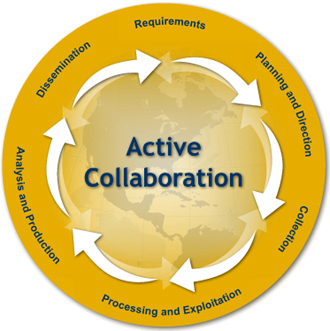Intelligence Cycle
Intelligence Cycle
The intelligence cycle is the process of developing unrefined data into polished intelligence for the use of policymakers. The cycle consists of six steps, described below. The graphic shows the circular nature of this process, although movement between the steps is fluid. Intelligence uncovered at one step may require going back to an earlier step before moving forward.
Requirements are identified information needs—what must be known to safeguard the nation. Intelligence requirements are established by the Director of National Intelligence according to guidance received from the president and the national and homeland security advisors. Requirements are developed based on critical information necessary to protect the United States from national security and criminal threats. The attorney general and the Director of the FBI participate in the formulation of national intelligence requirements.
Planning and Direction is management of the entire effort, from identifying the need for information to delivering an intelligence product to a consumer. It involves implementation plans to satisfy requirements levied on the FBI, as well as identifying specific collection requirements based on FBI needs. Planning and direction also is responsive to the end of the cycle, because current and finished intelligence, which supports decision-making, generates new requirements. The executive assistant director for the National Security Branch leads intelligence planning and direction for the FBI.
Collection is the gathering of raw information based on requirements. Activities such as interviews, technical and physical surveillances, human source operation, searches, and liaison relationships result in the collection of intelligence.
Processing and Exploitation involves converting the vast amount of information collected into a form usable by analysts. This is done through a variety of methods including decryption, language translations, and data reduction. Processing includes the entering of raw data into databases where it can be exploited for use in the analysis process.
Analysis and Production is the conversion of raw information into intelligence. It includes integrating, evaluating, and analyzing available data, and preparing intelligence products. The information’s reliability, validity, and relevance is evaluated and weighed. The information is logically integrated, put in context, and used to produce intelligence. This includes both “raw” and finished intelligence. Raw intelligence is often referred to as “the dots”—individual pieces of information disseminated individually. Finished intelligence reports “connect the dots” by putting information in context and drawing conclusions about its implications.
Dissemination—the last step—is the distribution of raw or finished intelligence to the consumers whose needs initiated the intelligence requirements. The FBI disseminates information in three standard formats: Intelligence Information Reports (IIRs), FBI Intelligence Bulletins, and FBI Intelligence Assessments. FBI intelligence products are provided daily to the attorney general, the president, and to customers throughout the FBI and in other agencies. These FBI intelligence customers make decisions—operational, strategic, and policy—based on the information. These decisions may lead to the levying of more requirements, thus continuing the FBI intelligence cycle.
07.09.10
| Intelligence Links |
|
Inside the Intelligence Branch Intelligence Primer Related Links Resources |


